Veiligheid / Safety

Veiligheid & Aromatherapie
*English below*
Zal de lavendelboer voortaan zo zijn lavendel moeten oogsten? Moet de toerist zo’n pak aantrekken alvorens hij in een lavendelveld mag rondwandelen? Als u deze foto ziet dan denkt u toch meteen: dit kan niet waar zijn… Maar soms leidt wetgeving tot dit soort associaties en waanbeelden omdat het lineair doortrekken van die wetgeving zou leiden tot dit soort praktijken.
Wat is er aan de hand met de wetgeving rond aromatherapie?
De Europese commissie produceert heel veel wetgeving die pas jaren later wordt ingevoerd of waarbij wordt besloten een overgangsperiode toe te staan waarna de wetten dus via controle en handhaving in de praktijk worden toegepast. Sinds enkele jaren zijn op bijvoorbeeld de tea tree olie flesjes van Chi al verschillende waarschuwingssymbolen gedrukt: ‘een vlammetje; een visje op de waterkant; een man met een ster op de borst’. Die zijn u misschien niet opgevallen omdat ze vrij klein op het etiket van het flesje staan en ook niet op het doosje voorkomen. Sinds 1 januari 2019 worden deze symbolen veel groter (1 x 1 cm) op de etiketten afgedrukt, maar ook op de doosjes. Want dit is verplicht voor alle bedrijven die met deze pure, 100% natuurlijke, aromatherapeutische grondstoffen werken. Wordt deze wetgeving niet op de producten geplaatst dan zal de Nederlandse Voedsel- en Warenautoriteit optreden.
Aromatherapie, een vreemde eend in de bijt
Deze symbolen staan voor stoffen die in potentie vlambaar, bijtend of op de een of andere manier schadelijk kunnen zijn voor de gezondheid van mens en dier. Het probleem voor de aromatherapie is nu dat er geen verschil wordt gemaakt tussen synthetisch gemaakte stoffen en 100% natuurlijke stoffen. De wet maakt geen onderscheid tussen deze stoffen. Dat is erg jammer want daarmee komt aromatherapie helaas in een negatief daglicht te staan. De wetgever weet zich eigenlijk met aromatherapeutische grondstoffen geen raad en plaatst ze daarom voor de zekerheid in het vakje: chemische stoffen die potentieel gevaarlijk zijn. Vergelijkbaar met die tankwagen vol chemische stoffen die niet door uw wijk mag rijden. In principe is dit natuurlijk logisch, want overmatig of verkeerd gebruik van bijvoorbeeld tea tree olie of pepermunt olie of welke andere olie dan ook, kan allergische reacties veroorzaken.
Belangrijk is om te beseffen voor u als gebruiker van etherische oliën of andere aromatherapie producten dat alle bedrijven die aroma’s op de markt brengen deze symbolen/waarschuwingstekens op hun producten en websites moeten vermelden. Als het ten minste om 100% etherische ofwel essentiële oliën gaat.
Nut van waarschuwen en weten wat je doet
Waarschuwen voor potentieel gevaar van een product is natuurlijk goed. Afschrikken is eigenlijk niet nodig maar veel mensen zullen er wel van schrikken. Als u deze redenering doortrekt zou eigenlijk op een pak keukenzout ook een doodskop moeten staan met de tekst: dodelijk na inname van 5 eetlepels! Want dit is een feit…maar wie gaat dit doen? Belangrijk is dat mensen goed en correct worden voorgelicht. Chi Natural Life adviseert al sinds 1979 druppelsgewijs gebruik van essentiële oliën, juist omdat het zo’n krachtige materialen zijn. U moet weten wat u doet als u deze grondstoffen gebruikt, zo simpel is het.
Van goede wil
Ofschoon wetgeving dus soms verwarrend is hebben wij in een democratie maar één ding te doen: ons houden aan de wetten die we met elkaar afspreken. Anderzijds misverstanden en onduidelijkheden voorkomen of zelfs uit sommige wetten halen is natuurlijk altijd goed. Chi Natural Life zal zich hier blijvend voor in zetten door zich aan de wet te houden maar ook door open en eerlijke voorlichting over deze wonderbaarlijke, geneeskrachtige, aromatherapeutische materialen.
Drs. Ton Beljon, directeur Chi Natural Life
Wet van Paracelsus (1494-1541):
“De dosis maakt het gif”
Aromatherapie, maar met gevarensymbolen
Aromatherapeutische grondstoffen zijn krachtige stoffen die gezondheid van mens en dier positief kunnen beïnvloeden. Daar legt Chi Natural Life altijd de nadruk op. Anderzijds communiceren wij ook al sinds 1979, heel open over de andere kant van aromatherapie als mensen die krachtige stoffen over doseren, en dus te veel gebruiken. Wij adviseren altijd: druppelsgewijs toepassen. En uiteraard altijd buiten bereik van kinderen houden. Met die voorzichtigheid in acht te nemen kunnen er prachtige resultaten zijn voor de gezondheid en welzijn van mens en dier.
Waarom gevarensymbolen?
De wetgevers en overheden moeten natuurlijk heel veel regels stellen, wetten maken en ook nog controleren. Dat leidt tot heel veel werk en soms wordt er dan besloten tot grove, ingrijpende en dwingende maatregelen en wetten die niet altijd logisch lijken of zelfs leiden tot verwarring en misverstanden. Een voorbeeld daarvan kan zijn de gevarensymbolen die op de aromatherapeutische grondstoffen vermeld moeten worden. Soms zitten hier stofjes in die door de natuur zijn aangemaakt en ingekapseld door andere stoffen in dit natuurproduct die ook voor komen in synthetische producten of andere door de mens samengestelde mixen. De overheid en dus de wet maakt in de beoordeling hiervan GEEN verschil. Dat zorgt er voor dat u op een flesje en/of doosje met 100% lavendel olie of tea tree olie dezelfde symbolen ziet staan als op een tankwagen die u op de weg ziet rijden met die ene geïsoleerde stof.
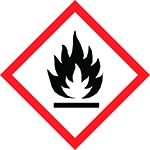
Teken 1: Ontvlambaar
Dit teken vindt u terug op ongelooflijk veel consumentenartikelen: van een fles spiritus tot een flesje schoonmaakalcohol. Etherische oliën kunnen ook brandbaar zijn en dus staat er om die reden deze waarschuwing ook op.
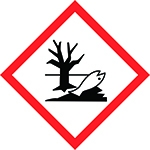
Teken 2: Milieugevaarlijk
Dit symbool ziet er al tamelijk gevaarlijk uit met een dood visje en een aangetaste, zieke boom; potentieel gevaarlijk voor het milieu, dus u vindt het terug op een flesje stickerverwijderaar, een fles terpentine etc. Helaas moet dit symbool ook op een aantal etherische oliën staan, zoals eucalyptus, omdat er minimale hoeveelheden stofjes van nature in zitten die volgens de wet dus potentieel milieugevaarlijk kunnen zijn. Het vreemde is dat massaal veel bladeren van Eucalyptusbomen – waar de olie dus uit gewonnen wordt – pal langs rivieren staan waarbij die bladeren gewoon veel in het water terecht komen en in het bijliggende bos, zonder enige schade voor het milieu ter plekke of voor de waterkwaliteit. Dit geldt ook voor een lavendelveld waarvan een deel niet geoogst wordt, de olie blijft in de plant en komt dus in het grondmilieu terecht zonder dat het schade veroorzaakt voor de natuur.
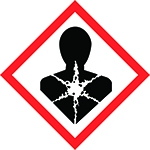
Teken 3: Lange termijn gezondheidsgevaar
Dit teken treft men aan op producten die bij voortdurend gebruik op de lange termijn een negatief gezondheidseffect zou kunnen hebben bij het inademen van deze stoffen. Schilders en spuiters van auto’s namen - meestal onbewust - soms in het verleden te veel risico en hebben deze stoffen bijvoorbeeld ingeademd. Verf wordt natuurlijk door mensen, vaak bijna volledig synthetisch gemaakt. De stoffen waarvan de overheid stelt dat ze problemen kunnen veroorzaken, komen vaak in minieme hoeveelheden van nature ook voor in bijvoorbeeld dennenolie, eucalyptus olie en lavendel olie. Dit symbool zou dus in feite betekenen dat u eigenlijk niet meer in de bossen moet lopen en u misschien beter een beschermingspak kunt aandoen als u een boswandeling maakt of eens tussen de lavendel wilt staan in Zuid-Frankrijk.
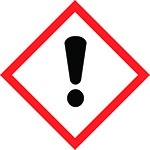
Teken 4: Acute gezondheidseffecten
Dit symbool ziet u vaak op geconcentreerde schoonmaakmiddelen als vaatwas tabletten, chloorbleekmiddelen en ontkalkers. Bij inslikken of diep ademhalen ontstaan er onmiddellijke gezondheidsrisico’s. Natuurlijk moet u met etherische oliën altijd goed opletten wat u doet en een slok van deze olie kan zeker ook gevaarlijk zijn. Aan de andere kant kunt u bij druppelsgewijs gebruik fantastische resultaten bereiken: wij adviseren regelmatig een druppeltje biologische pepermunt olie of tea tree op de tandpasta voor een extra frisse mond en keelholte. Maximaal 2 druppels pure lavendelolie op het kussen en daarna heerlijk inademen om beter in slaap te komen. Toch staan deze oliën op de lijst waarbij dit gevarensymbool op de verpakking moet! Een mooi voorbeeld dat past in de uitspraak van de 16de eeuwse arts en botanicus Paracelsus: “de dosis bepaalt of iets giftig is of niet”.

Teken 5: Bijtend
Dit teken ziet u op acuut bijtende stoffen zoals gootsteenontstopper, zoutzuuroplossingen e.d. Die stoffen kunnen de huid verbranden, aantasten en zelfs textiel en hout aantasten. Deze waarschuwing moeten wij o.a. ook op rozenolie, palmarosa en geranium zetten terwijl dit alle drie oliën zijn die we ook gebruiken in heel succesvolle producten om de huid rustig te krijgen en te herstellen. Dit is ook een voorbeeld van de grofmazigheid van wetgeving. Omdat bepaalde stofjes in deze oliën voorkomen moet dit symbool erop. Maar juist deze werkzame stofjes zitten er niet geïsoleerd in maar ingebed in een veelheid van werkzame stoffen, waardoor het juist als totale olie ideaal is als ingrediënt in een huidverzorgingsproduct.
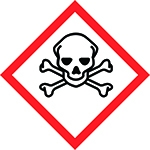
Teken 6: Giftig
Dit afschrikkende beeld vindt u terug op producten die giftig kunnen zijn en zelfs dodelijk bij verkeerd gebruik. Die vindt u vaak niet eens in de winkel en zijn vaak niet verkrijgbaar voor consumenten. Maar staat bijvoorbeeld toch ook op anti-vries of ontdooiingsmiddelen. Toch vindt u dit symbool ook in twee gevallen op etherische oliën: kaneel en oregano. Ook hier speelt natuurlijk, zoals bij al deze waarschuwingssymbolen, het feit dat de wetgever maar een beperkt aantal vakjes heeft om grondstoffen in te stoppen. Want het is natuurlijk ergens ridicuul maar op zijn minst heel apart te noemen dat kaneel olie in heel veel snoepgoed en koekjes verwerkt wordt die we vaak toch erg lekker vinden en dus massaal eten! Oregano olie werd lang voor de ontdekking van het antibioticum door veel deskundigen geadviseerd bij dezelfde indicaties en door veel top koks anno 2019 verwerkt in hun uitmuntende 100% natuurlijke soepen. Dit is ook weer een goed voorbeeld van de stelling: de dosis bepaalt of iets giftig wordt. Belangrijk is dat aroma’s altijd druppelsgewijs worden ingezet en met voorzichtigheid om zo optimaal te profiteren van de natuurlijke mogelijkheden om een ondersteuning te zijn voor de gezondheid!
Safety & Aromatherapy
Will the lavender farmer have to harvest his lavender this way from now on? Does the tourist have to put on such a suit before he can walk around in a lavender field? When you see this photo, you immediately think: this cannot be true... But sometimes legislation leads to these types of associations and delusions because a linear extension of that legislation would lead to these types of practices.
What's going on with the legislation surrounding aromatherapy?
The European Commission produces a lot of legislation that is only introduced years later or where it is decided to allow a transition period after which the laws are applied in practice through control and enforcement. For several years now, various warning symbols have been printed on Chi's Tea Tree oil bottles. For example: 'a flame; a fish on the water's edge; a man with a star on his chest'. You may not have noticed these because they are quite small on the label of the bottle and do not appear on the box. Since January 1, 2019, these symbols have been printed much larger (1 x 1 cm) on the labels, but also on the boxes. Because this is mandatory for all companies that work with these pure, 100% natural, aromatherapeutic raw materials. If this legislation is not placed on the products, the Dutch Food and Consumer Product Safety Authority will take action.
Aromatherapy, an odd one out
These symbols represent substances that are potentially flammable, corrosive or in some way harmful to the health of humans and animals. The problem for aromatherapy now is that no difference is made between synthetically made substances and 100% natural substances. The law makes no distinction between these substances. That is a shame because it unfortunately puts aromatherapy in a negative light. The legislator does not know what to do with aromatherapeutic raw materials and therefore, to be on the safe side, places them in the box: chemical substances that are potentially dangerous. Comparable to that tanker full of chemicals that is not allowed to drive through your neighborhood. In principle this makes sense, because excessive or incorrect use of, for example, tea tree oil or peppermint oil or any other oil can cause allergic reactions.
It is important for you as a user of essential oils or other aromatherapy products to realize that all companies that market aromas must include these symbols/warning signs on their products and websites. At least if it concerns 100% essential oils.
Usefulness of warning and knowing what you are doing.
Warning about the potential danger of a product is of course good. Deterrence is not actually necessary, but it will frighten many people. If you extend this reasoning, a pack of table salt should also have a skull on it with the text: fatal after ingesting 5 tablespoons! Because this is a fact…but who is going to do this? It is important that people are well and correctly informed. Chi Natural Life has been recommending the use of essential oils drop by drop since 1979, precisely because they are such powerful materials. You need to know what you are doing when you use these raw materials, it's that simple.
Of good will
Although legislation is sometimes confusing, in a democracy we only have one thing to do: adhere to the laws that we agree on with each other. On the other hand, it is always good to prevent misunderstandings and ambiguities or even to remove them from some laws. Chi Natural Life will continue to commit to this by adhering to the law, but also by providing open and honest information about these wonderful, medicinal, aromatherapeutic materials.
Drs. Ton Beljon, director of Chi Natural Life
Law of Paracelsus (1494-1541):
“The dose makes the poison.”
Aromatherapy, but with hazard symbols
Aromatherapeutic raw materials are powerful substances that can positively influence the health of humans and animals. Chi Natural Life always emphasizes that. On the other hand, we have been communicating very openly since 1979 about the other side of aromatherapy when people over-dose powerful substances and therefore use too much. We always recommend apply drop by drop. And of course, always keep out of reach of children. By exercising this caution, there can be wonderful results for the health and well-being of humans and animals.
Why hazard symbols?
Legislators and governments must of course set a lot of rules, make laws and also monitor them. This leads to a lot of work and sometimes it is decided to adopt harsh, drastic and coercive measures and laws that do not always seem logical or even lead to confusion and misunderstandings. An example of this could be the hazard symbols that must be stated on aromatherapy raw materials. Sometimes this contains substances that are created by nature and encapsulated by other substances in this natural product that also occur in synthetic products or other man-made mixes. The government and therefore the law makes NO difference in the assessment of this. This ensures that you see the same symbols on a bottle and/or box with 100% lavender oil or tea tree oil as on a tanker truck that you see driving on the road with that one isolated substance.

Sign 1: Flammable
This sign can be found on an incredible number of consumer items: from a bottle of spirits to a bottle of cleaning alcohol. Essential oils can also be flammable, which is why this warning is included.

Sign 2: Environmentally hazardous
This symbol already looks quite dangerous with a dead fish and an affected, diseased tree; potentially dangerous for the environment, so you will find it on a bottle of sticker remover, a bottle of turpentine, etc. Unfortunately, this symbol must also appear on several essential oils, such as eucalyptus, because they contain minimal amounts of naturally occurring substances that are therefore prohibited by law that could be potentially environmentally hazardous. The strange thing is that a lot of leaves from Eucalyptus trees - from which the oil is extracted - are located right along rivers, whereby those leaves simply end up in the water and in the surrounding forest, without any damage to the local environment or to water quality. This also applies to a lavender field, part of which is not harvested, the oil remains in the plant and therefore ends up in the soil environment without causing damage to nature.

Sign 3: Long-term health hazard
This sign is found on products that, if used continuously, could have a negative health effect in the long term by inhaling these substances. Painters and car painters sometimes took too many risks in the past - usually unconsciously - and inhaled these substances, for example. Paint is, of course, made by people, often almost completely synthetically. The substances that the government states can cause problems often occur naturally in minute quantities, for example in pine oil, eucalyptus oil and lavender oil. This symbol would in fact mean that you should no longer walk in the woods and it might be better to put on a protective suit if you take a walk in the woods or if you want to stand among the lavender in the south of France.

Sign 4: Acute health effects
You often see this symbol on concentrated cleaning products such as dishwasher tablets, chlorine bleach and descalers. Immediate health risks arise if swallowed or inhaled deeply. Of course, you always must pay close attention to what you are doing with essential oils and a sip of this oil can certainly be dangerous. On the other hand, you can achieve fantastic results if you use it drop by drop: we recommend regularly adding a drop of organic peppermint oil or tea tree to the toothpaste for an extra fresh mouth and throat. Place a maximum of 2 drops of pure lavender oil on the pillow and then inhale deeply to help you sleep better. Yet these oils are on the list that requires this hazard symbol on the packaging! A good example that fits the statement of the 16th century physician and botanist Paracelsus: “the dose determines whether something is poisonous or not”.

Sign 5: Corrosive
You will see this sign on acutely corrosive substances such as sink unblocker, hydrochloric acid solutions, etc. These substances can burn and corrode the skin and even attack textiles and wood. We must also apply this warning to rose oil, palmarosa and geranium, among others, while all three of these are oils that we also use in very successful products to soothe and restore the skin. This is also an example of the coarseness of legislation. Because certain substances occur in these oils, this symbol must be displayed. But it is precisely these active ingredients that are not isolated, but embedded in a multitude of active ingredients, making it ideal as a complete oil as an ingredient in a skin care product.

Sign 6: Toxic
This frightening image can be found on products that can be poisonous and even fatal if used incorrectly. You often don't even find these in stores and are often not available to consumers. But it also contains anti-freeze or defrosting agents, for example. However, you will also find this symbol on essential oils in two cases: cinnamon and oregano. Of course, here too, as with all these warning symbols, the fact that the legislator only has a limited number of boxes in which to put raw materials. Because it is of course ridiculous but at least very strange that cinnamon oil is used in a lot of sweets and cookies that we often find very tasty and therefore eat massively! Long before the discovery of the antibiotic, oregano oil was recommended by many experts for the same indications and used by many top chefs in 2019 in their excellent 100% natural soups. This is another good example of the statement: the dose determines whether something becomes toxic. It is important that aromas are always used drop by drop and with caution in order to take full advantage of the natural possibilities to support health!


